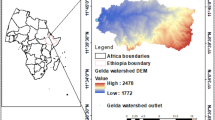Abstract
Evaluation of the morphometric parameters requires preparation of drainage map, contour map, ordering of the various streams and measurements of catchment area, perimeter, relative relief, relief ratio, length of drainage channels, drainage density, drainage frequency, bifurcation ratio, texture ratio, circulatory ratio and constant channel maintenance, which help to understand the nature of the drainage basin. The present study involves the Geographic Information System (GIS) analysis techniques to evaluate and compare linear, relief and aerial morphometry of the five subwatersheds of Song River (tributary of the Ganga River) with special reference to landslide incidences, for future development and planning of the watershed. Jakhan Rao, Song River, Bandal Nadi, Baldi Nadi and Suswa Nadi are the five major subwatersheds of the Song River basin. All the subwatersheds are basically of 5th to 6th order. Drainage patterns are mainly dendritic to sub dendritic. The drainage pattern of the Song River basin is mainly structurally controlled and the area is characterized by high to moderate relief. The asymmetric factor indicates that the tectonic rotation of the four subwatersheds is upward on the right side of the drainage basin and only one sub-watershed is downward. The numbers of the landslide incidences are also more in the upward side, than the downward side of the Song River basin.
Similar content being viewed by others
References
Coasta John E and Fleisher P Jay (1984) Developments and application of Geomorphology, Springer Verlag, New York
Horton RE (1945) Erosional development of streams and their drainage basins; Hydrophysical approach to quantative morphology. Bull, Geo. Soc. Am. Vol 56, pp. 275–370
Leopold LB, Wolman M Gordon and Miller John P (1964) Fluvial processes in geomorphology, Chapter 5, “Drainage basin as a geometric unit”. Ed. WH Freeman and Company; San Francisco and London
Morisawa M (1985) Geomorphology texts books: rivers, forms and process, Chapter 5, “Structural and lithological control”
Nautiyal MD (1994) Morphometric analysis of a drainage basin using arial photographs: A case study of Khairkuli Basin, District Dehradun, U.P.
Strahler AN (1964) Quantative geomorphology of drainage basins and channel networks, Hand book of Aplied Hydrology; Ed. By Ven Te Chow, McGraw Hill Book Company, New York
Strahler AN (1968) Physical Geography, 3rd Edition, Chapter 29, “Quantative analysis of erosional landform”
Vijith H and Sathesh R (2006) GIS based morphometric analysis of two major upland sub-watersheds of Meenachil River in Kerala
Author information
Authors and Affiliations
Corresponding author
About this article
Cite this article
Pankaj, A., Kumar, P. GIS-based morphometric analysis of five major sub-watersheds of Song River, Dehradun District, Uttarakhand with special reference to landslide incidences. J Indian Soc Remote Sens 37, 157–166 (2009). https://doi.org/10.1007/s12524-009-0007-9
Received:
Accepted:
Published:
Issue Date:
DOI: https://doi.org/10.1007/s12524-009-0007-9




